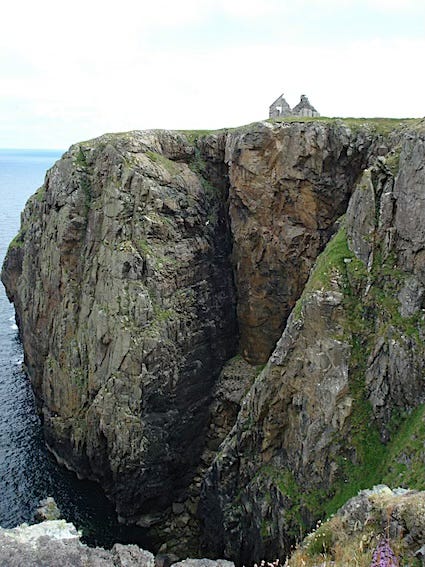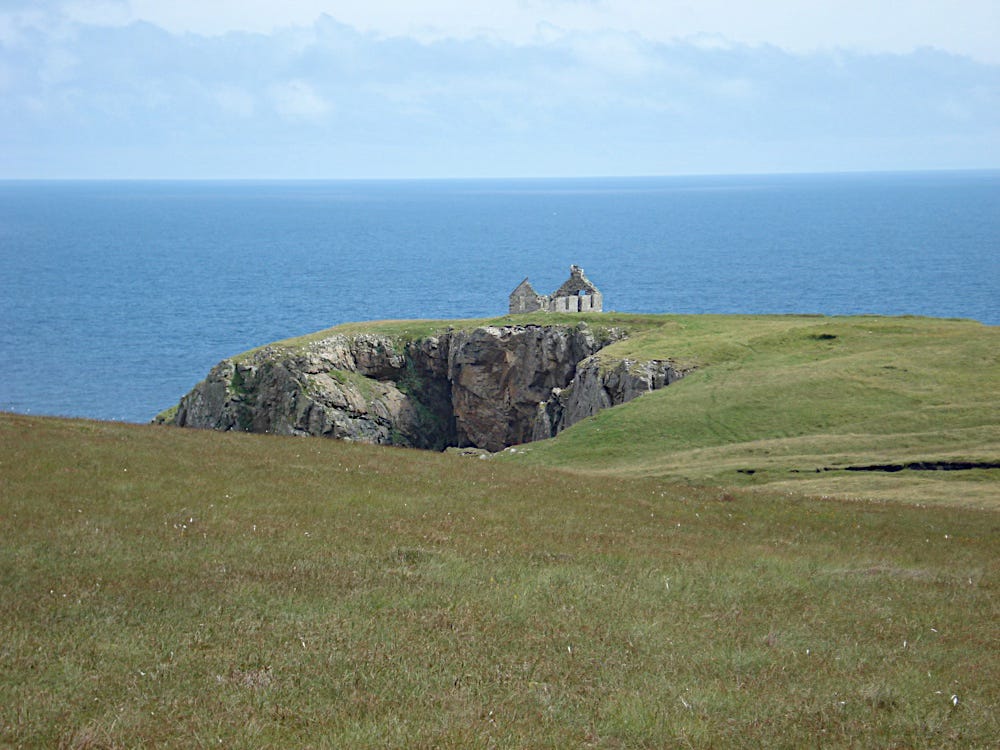Iain Fiosaich's House - Taigh 'An Fiosaich
On the moor in Lewis, a house surrounded on three sides by high cliffs has an amazing story.
Gaelic version below.
John Nicolson (’An Fiosaich) was a Minister. He built this house (his second), close to the shielings where people would spend the Summer. If you sat inside and tossed an orange out the window, it would take a few seconds before it hit the sea. Splash.
He was a Minister. This was the second house he built. There was also a small chapel—Filiscleitir Chapel. We went there every year for walks when I was young. A small oil lamp (a crùisgean) sat in the window, and I liked finding it exactly where I had left it, even though there was no window anymore.
My grandmother spent her summers there when she was young, looking after cattle. She only got an orange once a year. It came from Iain Fiosaich and his wife at the Christmas party they held for the village children.
The house stood near the Filiscleitir shielings, on the moor between Ness and Tolsta. Closer to Ness, and it’s from the villages in Ness that the people came from. My grandmother would spend about three months there, watching over the cattle, making cheese, doing what had to be done. They had to grow crops on the crofts to keep them going through the winter.
At one time, people moved to Cuisiadar and Airigh a’ Bhealaich. In the 1950s, they stopped going to the shielings for the summer. But even now, plenty of people have huts and little bothies there. Some have neat little lawns.
The people of Ness love the shielings. And why wouldn’t they? We had a caravan there when I was young. I’ve traveled a lot, but is there anywhere like being out on the moor at the shieling in Ness? No. Maybe it’s just that I was young. In my memory, the light was golden. The birds sang, full of joy. The river made a soft, gentle sound. There’s a well in Cuisiadar, and the water there is sweet.
Iain Fiosaich married a rich woman from America—Norah Barney Cushing. They had one son, Percy. Every day, Percy took a bun with icing to school. The other children watched him, longing for that bun, the icing as white as Antarctica, while they had only a small piece of bread. We once had a dog named Percy, because of his love for sweet things.
Iain Fiosaich and his wife spent time in London, sometimes gathering charitable donations of clothes to bring back to Ness.
They had servants in that house on the cliff. My mother’s aunt, Ceiteag, worked there. Tàbaidh, a man from the village, brought the mail to them every day. The servants were paid six shillings a week.
Iain Fiosaich loved to climb. There were plenty of places for that. In front of the house, there is a grave. A sailor is buried there—a man Iain Fiosaich found at the foot of the cliff. I always wondered how he got down there, with the cliffs so steep. But if you go through the house and down the little path behind it, there is a way. It’s steep, but it takes you to the sea.
The loss of the Iolaire in 1918 was a heavy blow for him. He thought about the boys who had died, the ones who had once attended his Sunday School.
He did a lot for the community. The Ness Historical Society wrote a pamphlet about him. It’s worth reading. And if you are ever in Ness, it’s a very special place to visit.
GAELIC VERSION
Air bàrr na creige, tha taigh. Taigh ‘An Fiosaich. Faisg air na h-àiridhean dham biodh daoine a’ dol fad an t-Samhraidh. Nam biodh tu a’ gabhail fois ann, agus nan sadadh tu orainsear a-mach air an uinneig, bheireadh e grunn dhiogan mus ruigeadh e a’ mhuir. Splais.
‘S e Ministear a bh’ ann. Seo an dàrna taigh a thog e, agus cuideachd, tha teampull bheag ann. Teampull Filiscleitir. Bhiodh sinn a’ gabhail chuairt ann a h-uile bliadhna. Bha crùisgean bheag anns an uinneig, agus bha e a’ còrdadh rium nuair a lorgainn e fhathast far na dh’fhàg mi e, ged nach robh uinneag ann.
Cha robh mi sheanmhair, a bhiodh a’ cur seachad a cuid samhraidhean ann nuair a bha i òg, a’ coimhead às dèidh a’ chruidh air an àirigh, a’ faighinn orainsear ach aon turas sa bhliadhna. Agus, ‘s ann bho Iain Fiosaich agus a bhean aige a bhiodh i ga fhaighinn, aig pàrtaidh Nollaig a bhiodh iad a’ cur air dòigh dha clann a’ bhaile.
Bha an taigh faisg air àiridhean Filisceitir, air a’ mhòintich eadar Nis agus Toltastadh. Nas fhaisg air Nis, oir ‘s ann bho bhailtean ann an Nis a bhiodh daoine a’ tighinn. Bhiodh mo sheanmhair a’ cur seachad mu thrì mhìosan ann, a’ coimhead às dèidh a’ chruidh, a’ dèanamh càise agus a leithid. Bha aca ri na lotaichean a chleachdadh gus rudan eile fhàs a chumadh tron Gheamhradh iad,
Ghluais daoine a-steach aig aon àm, gu Cuisiadar agus Àirigh a’ Bhealaich, agus anns na 50mh, stad daoine a’ dol a-mach ann leis a’ chruidh airson an t-Samhraidh air fad. Ach fhathast, an latha an-diugh, tha gu leòr dhaoine aig a bheil hutaichean agus bothagan beaga ann. Feadhainn aig a bheil lawns beaga, grinn.
Tha muinntir Nis uabhasach dèidheil air na h-àirighean. Agus carson nach biodh? Bha carabhan againn fhìn ann nuair a bha mi òg. Tha mi air tòrr siubhal a dhèanamh, ach a bheil àite eile a tha a’ tighinn faisg air a bhith air an àiridh air mòinteach Nis? Chan eil. ‘S mathaid gur e dìreach, gun robh mi òg. Nam chuimhne, bha solas òr ann. Bha iseannan a’ ceilearaich, agus iad fhèin cho dòigheil, agus bha fuaim na h-aibhne ann, cho socair agus binn. Tha tobair ann an Cuisiadar, agus abair gu bheil am bùrn a gheibh thu innte milis.
Phos ‘An Fiosaich tè gu math beartach à Ameireaga, Norah Barney Cushing. Bha aon mhac aca, Percy. ‘S e Percy an t-ainm a bh’ air cù a bh’ againn aig aon àm, oir bha e uabhasach dèidheil air rudan milis. Bhiodh Percy (am balach) a’ toirt, gach latha, buna le icing dhan sgoil. Agus bhiodh a’ chlann eile a’ coimhead air, le miann am beatha aca air a’ bhuna sin, an icing cho geal ri Antartaiga, gun ach pìos beag lof aca.
Bhiodh iad a’ cur seachad ùine ann an Lunnainn, agus bhiodh iad a’ cruinneachadh aodach nuair a bha iad ann, a bheireadh iad air ais a Nis.
Bha cuideachd, searbhantan aca, anns an taigh seo air oir na creige. Bhiodh Ceiteag, auntie mo mhàthar ag obair ann. Bhiodh Tàbaidh, fear às a’ bhaile, a’ toirt a’ phuist a-mach thuige gach latha. Bhiodh iad a’ faighinn sia sgilling gach seachdainn, na searbhantan..
Bha Iain Fiosaich cuideachd uabhasach dèidheil air sreap. Agus bha gu leòr àitichean ann far am faodadh e sin a dhèanamh. Tha uaigh ann, air beulaibh an taighe, far a bheil seòladair air a thiodhlaicheadh, fear a lorg Iain Fiosaich aig bonn na creige. Bha ceistean agam a-riamh mu dheidhinn ciamar a dh’fhaodadh e sin a dhèanamh agus na creagan cho cas, ach ma thig thu tron taigh agus sìos na lianaig air a chùlaibh, tha slighe ann. Tha e cas, ach gheibh thu sìos chun na mara ann.
‘S e buille chruaidh a bh’ ann an call na h-Iolaire ann an 1918, agus e a’ smaoineachadh air na balaich a chaise an call, a chleachd a bhith anns an Sgoil Shàbhaid aige.
Rinn e tòrr airson na coimhearsnachd, agus tha Comunn Eachdraidh Nis air pamphlet a sgrìobhadh mu dheidhinn, agus ‘s fhiach a leughadh. Agus ma tha sibh a-riamh ann an Nis, ‘s e àite gu math sònraichte a th’ ann airson cuairt.
DEIREADH.



